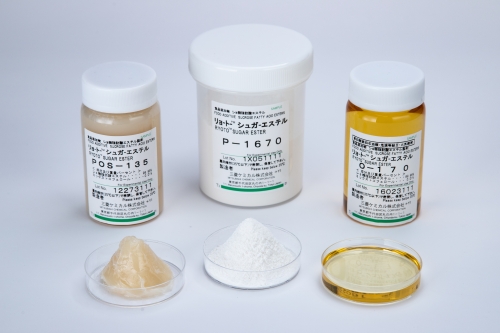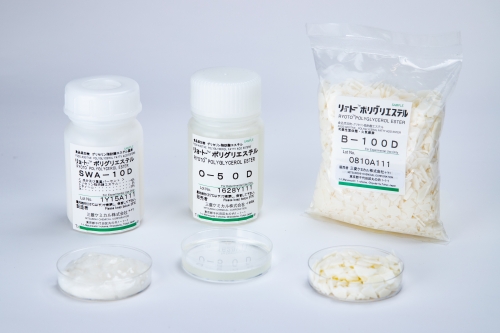
Manufacturing Process and Chemical structure
RYOTO™ Polygly Esters are synthesized by esterifying some or all of the hydroxyl groups of polyglycerin—produced via dehydration condensation of glycerin derived from vegetable oils—with fatty acids also derived from vegetable oils. The hydrophilic component, polyglycerin, has an average degree of polymerization of 10 (Deca) with its distribution range. Fatty acids, which serve as the lipophilic component, are esterified onto this polyglycerin at various ratios. As a result, the product becomes a mixture of esters with many different chemical structures, giving rise to a wide range of functional properties.
Furthermore, our proprietary manufacturing process and quality control have enabled us to achieve improved flavor and stable quality management.
Manufacturing Process
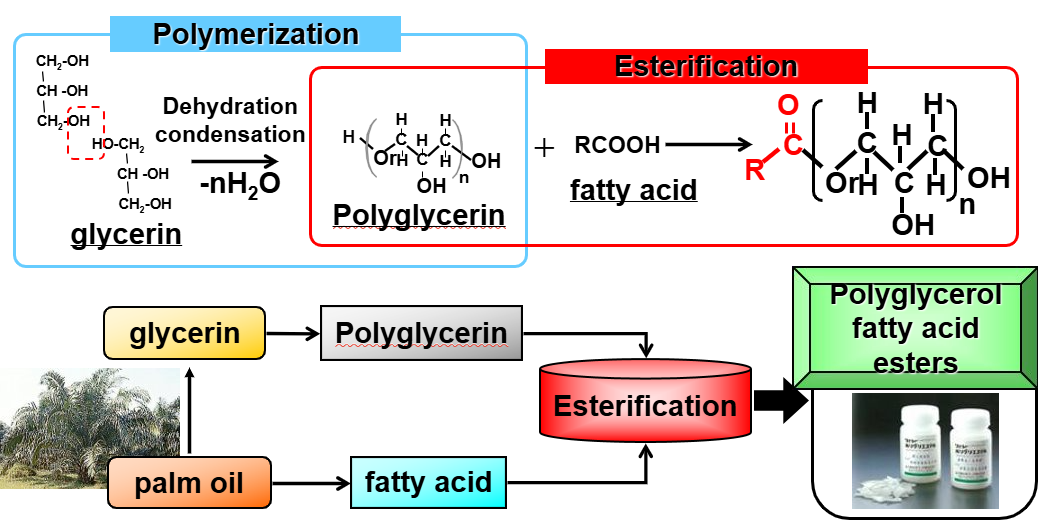
Characteristics of RYOTO™ Polygly Esters

Functions (Features) of RYOTO™ Polygly Esters
Because of the properties of polyglycerin as a hydrophilic group, RYOTO™ Polygly Esters have superior acid and salt resistance compared to sucrose fatty acid esters. This makes them widely suitable for acidic beverages and seasonings.
Additionally, RYOTO™ Polygly Esters form a thick hydration layer in O/W emulsions due to the polymeric chain structure of polyglycerin, thereby stabilizing the emulsion. Polyglycerol Esters with shorter fatty acid chain lengths have the property of superior solubilization ability.
Comparison of Sugar Esters and Polyglycerol Esters

Polyglycerol Esters Suitable for Solubilization
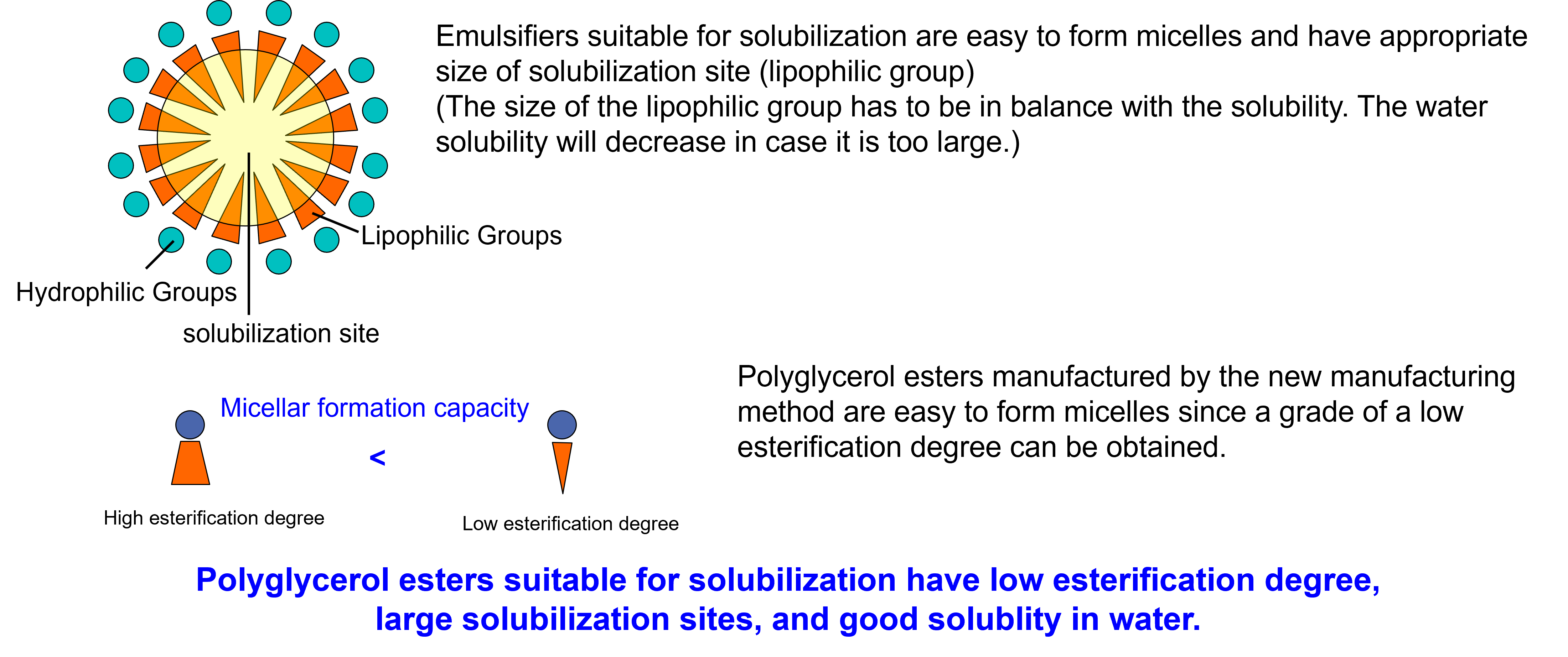
Product Lineup of RYOTO™ Polygly Ester
RYOTO™ Polygly Esters are available in a wide range of grades based on the type of fatty acid (e.g., lauric acid, stearic acid, oleic acid) and HLB values. The HLB value indicates the balance between hydrophilicity and lipophilicity, allowing selection of the appropriate grade according to the intended application.
RYOTO™ Polygly Ester Product Range
| Constituent Fatty Acids | HLB | |||||||||
| ≦3 | 4 | 5 | 7 | 11 | 13 | 14 | 15 | 16 | 17 | |
| Lauric Acid C12 | CA-F4 | L-10D | L-7D | |||||||
| Myristic Acid C14 | M-10D | M-7D | ||||||||
| Stearic Acid C18 | SWA-20D | SWA-10D | ||||||||
| Oleic Acid C18' | O-50D | O-15D | O-7D | |||||||
| Behenic Acid C22 | B-100D | B-70D | ||||||||

Applications by RYOTO™ Polygly Ester Grade
Hydrophilic grades such as SWA-10D and SWA-20D are widely used for emulsion stabilization in acidic dairy beverages, sauces, and dressings, leveraging their strong hydration capacity, acid resistance, and salt resistance.
Other highly hydrophilic grades such as L-7D, M-7D, and O-7D are applied for solubilizing flavors and functional ingredients due to their excellent hydrophilicity.
On the other hand, lipophilic grades such as B-100D and B-70D are used to improve the physical properties of chocolate and paste-type seasonings by promoting fat crystallization and increasing viscosity.
O-50D has the ability to reduce interfacial tension and exhibits self-emulsifying properties, making it suitable for improving the dispersibility of functional oils and rice cooking oils in water. It also possesses defoaming functionality, making it a uniquely featured emulsifier.
Effect of Polyglycerol Esters on the Emulsion Stability of Acidic Dairy Beverages
Sugar Esters (SE): Emulsion breaks down completely, resulting in cream separation.
Polyglycerol Esters (POGE): Emulsion remains stable, with good re-dispersibility of cream even under acidic conditions.

Viscosity Control of Liquid Oils Using RYOTO™ Polygly Esters
(Powder Dispersion in Oil)

Application of RYOTO™ Polygly Esters to Rice Crackers – Enhanced Penetration of Seasoning Oil
By adding O-50D to vegetable oil, the absorption rate of oil into rice crackers was accelerated.
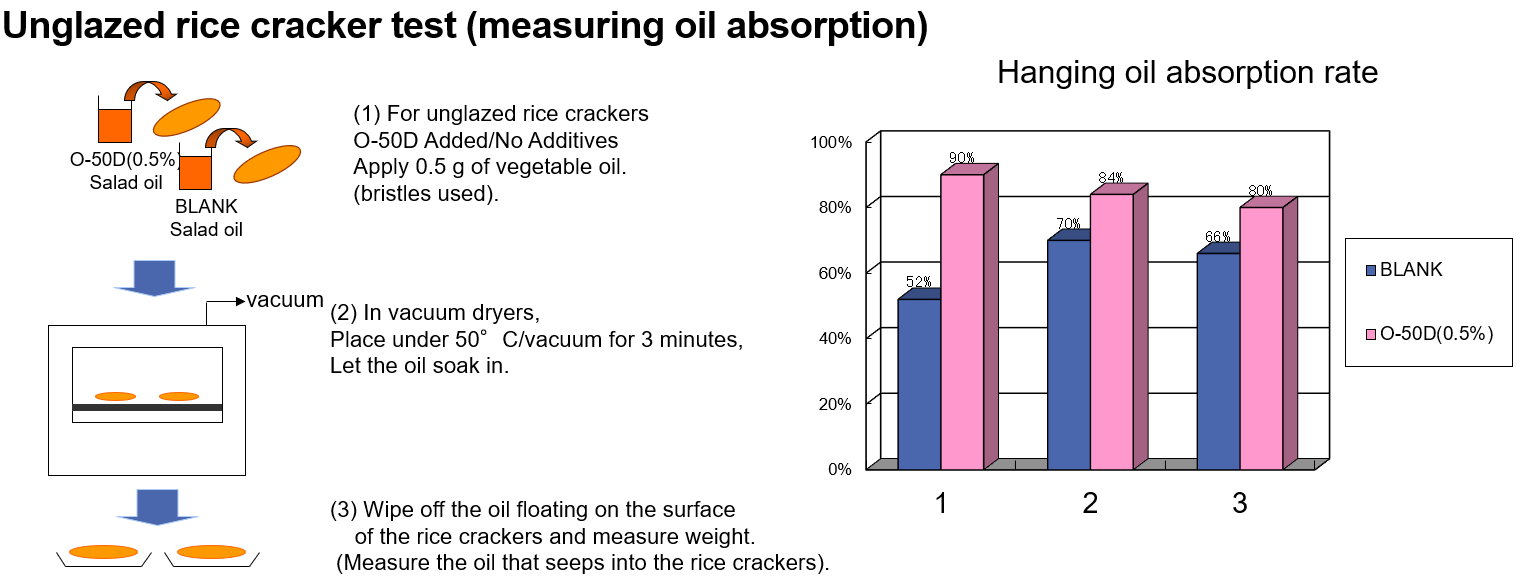
Usage Instructions for RYOTO™ Polygly Esters
Hydrophilic grades with high HLB values should be added to water.Lipophilic grades with low HLB values should be added to oils and fats.In both cases, after addition, heat the mixture above the melting point of the polyglycerol fatty acid ester (60°C–80°C, 140°F–176°F), stir thoroughly to dissolve, and then use. Some grades of RYOTO™ Polygly Esters are highly viscous semi-solid products. Heating improves fluidity, so warming is recommended during portioning or weighing.
Certifications of RYOTO™ Polygly Esters
RYOTO™ Polygly Esters are approved as food additives in Japan. For overseas approvals and various religious certifications, please contact our sales representatives.

